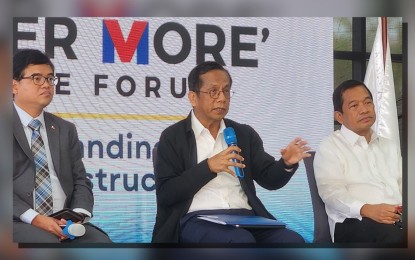
BOUNCING BACK. National Economic and Development Authority Secretary Arsenio Balisacan (center) explains how the Build Better More infrastructure program of the government will propel private spending in the construction sector and help them bounce back from the pre-pandemic level. Balisacan, along with DOF Undersecretary Rolando Tungpalan (right) and DBM Assistant Secretary Romeo Matthew Balanquit (left), graced a forum at New Clark City in Capas, Tarlac on Friday (July 12, 2024). (PNA photo by Kris M. Crismundo)
CAPAS, Tarlac – National Economic and Development Authority (NEDA) Secretary Arsenio Balisacan said private construction may return to pre-pandemic level next year with the easing of inflation and interest rates.
At the Build Better More Infrastructure Forum here Friday, Balisacan said the performance of construction sector has yet to fully recover since the coronavirus disease 2019 (Covid-19) pandemic struck in 2020.
“This lag is attributable to several factors. First, we expected some investor hesitation owing to initial policy uncertainty brought about by elections 2022. On the other hand, lingering and persistent inflation, and a challenging external environment particularly a strong dollar in the past two years to the elevated interest rates we see today,” he said.
The NEDA chief said the current spending level of the private sector in construction activities is “not that too far” from the pre-Covid-19 level, so it is possible that private spending on construction will bounce back pre-pandemic level in 2025.
He added that as the Marcos administration usher the country into the golden age of infrastructure through the Build Better More infrastructure program, more investors both from local and foreign sources are expected to put their capital in these projects.
“With public investments coming in strongly, that will be the signal for the private sector to come in too, especially that regional and global community investment climate is improving, notwithstanding these geopolitical tensions, because that’s another factor that can matter. But I think, we are there,” Balisacan said.
He said the easing of inflationary pressures that could lead to policy rate cuts will propel the private sector to borrow money and put their capital in the 185 infrastructure flagship projects (IFPs) of the government.
76 flagship projects
Of the current 185 IFPs, the government targets to complete 76 within the term of President Marcos, Balisacan's presentation showed.
Balisacan reported that 15 projects are being eyed to be delivered this year; 11 IFPs to be finished in 2025; and eight to be completed in 2026.
Bulk of the projects targeted for completion will be in 2027 with a total of 23 IFPs.
In the last year of the Marcos administration, 19 projects are seen to be delivered.
Balisacan said 103 projects are slated for completion beyond 2028, while five IFPs are still to be confirmed with the implementing agencies for the target year of completion.
In 2023, President Marcos inaugurated the first IFP completed during his term, the Samar Pacific Coastal Road Project.
Balisacan is optimistic that these projects will be delivered on time following the issuance of Executive Order No. 59 to streamline processes of permits for IFPs to expedite their implementation.
“We expect to see the speedier rollout of more and more projects, including those involving LGUs (local government units) in the years to come,” the NEDA chief said.
Funding
In the same forum, Department of Finance Undersecretary Rolando Tungpalan said official development assistance (ODA) accounted for the majority of funding for IFPs.
Eighty-two projects are ODA-backed projects amounting to PHP5.48 trillion, or 57.5 percent of the total PHP9.535 trillion cost of the 185 IFPs.
Tungpalan said borrowings through ODAs allow the government “to continue spending productively without straining our fiscal space”.
“ODA provides the most concessional financing with lower interest rates, longer grace periods, and longer amortization or maturity period,” he added.
With the administration’s strong push for public-private partnership (PPP), there will be 43 PPP-funded IFPs with project cost of PHP2.75 trillion.
IFPs fully funded by the government using the General Appropriations Act (GAA) stood at 50 projects amounting PHP993 billion.
Other projects use mix of fund sources.
ROW bill
Meanwhile, Balisacan highlighted the need for the passage of the right-of-way (ROW) bill into law to ensure the timely completion of flagship infrastructure projects.
He prodded the Congress to act on the pending bill, saying that right-of-way issues remain the “most critical” challenge for completion of critical infrastructure projects.
“Of course the right way issue remains the most critical challenge that we are facing. So, we are going back to Congress for the amendment of the right-of-way law,” Balisacan said, adding that they are hoping for its passage within the President’s term.
Balisacan said among the game-changing provisions of the proposed law is the valuation of property which would ensure “faster and more efficient way of resolving conflicts between the private owner and government”, while at the same time ensuring “fairness in respect to ownership.”
For his part, Tungpalan said the government is also looking at ways to ease expropriation process.
“It’s a very long, tedious process and we’re finding ways to speed it up that would be fair to the both the land owner and the government enjoying the benefits of government,” he said.
Earlier, President Ferdinand R. Marcos Jr. ordered the return to the “old process” of resolving right-of-way issues, which include securing the writ of possession after making a 15 percent initial payment for the property affected.
The step is aimed at addressing bottlenecks in the infrastructure projects while waiting for the passage of the right-of-way bill. (PNA)
